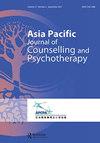Racial teasing and body dysmorphic disorder symptoms – A cross-sectional study of Asian ethnic groups in Singapore
IF 0.5
4区 心理学
Q4 PSYCHOLOGY, CLINICAL
Asia Pacific Journal of Counselling and Psychotherapy
Pub Date : 2020-01-02
DOI:10.1080/21507686.2019.1708425
引用次数: 4
Abstract
ABSTRACT Preliminary evidence suggests that racial teasing can adversely affect the body image of ethnic minority groups. This study investigated the frequency of racial teasing across ethnic groups, related distress and skin colour dissatisfaction, and examined whether racial teasing predicts body dysmorphic disorder symptoms. A cross-sectional web-based survey was completed by 287 participants, identified as Chinese, Malay or Indian in Singapore (Mage = 23.05, SDage = 4.63). Ethnic minority participants reported higher frequency, distress and skin colour dissatisfaction than Chinese individuals. Past distress due to skin colour teasing predicted skin colour dissatisfaction. Lastly, racial teasing predicted body dysmorphic symptoms over and above control variables. Racial teasing appears to be a significant source of appearance concerns that should not be overlooked.种族戏弄和身体变形障碍症状——新加坡亚裔群体的横断面研究
初步证据表明,种族调侃会对少数民族的身体形象产生不利影响。这项研究调查了不同种族群体的种族调侃频率、相关的痛苦和对肤色的不满,并检验了种族调侃是否预示着身体变形障碍症状。一项基于网络的横断面调查由287名参与者完成,他们被确定为新加坡的华人、马来人或印度人(Mage=23.05,SDage=4.63)。少数族裔参与者报告的频率、痛苦和肤色不满高于中国人。过去因肤色调侃而产生的苦恼预示着对肤色的不满。最后,种族调侃预测的身体变形症状超过了控制变量。种族调侃似乎是不应忽视的外表问题的一个重要来源。
本文章由计算机程序翻译,如有差异,请以英文原文为准。
求助全文
约1分钟内获得全文
求助全文

 求助内容:
求助内容: 应助结果提醒方式:
应助结果提醒方式:


